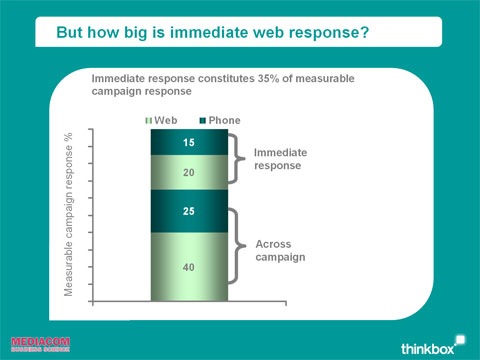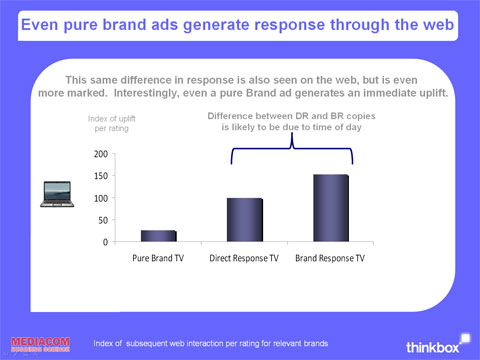After attending a Thinkbox conference in Manchester a few months ago, it spurred on some thoughts around the expansive applications of SEO to other media channels; where so many marketing opportunities can be developed to develop an organic competitive advantage.
Working as part of an SEO team for MEC, a media buying and planning agency, and as part of the Digital and Interaction department, I’m lucky enough to work alongside the Broadcast, Press, Strategy and Analytics & Insights departments. In this kind of environment, you can imagine how exposed you might be to the many possible and actual integration opportunities across what we call Paid, Earned and Owned media campaigns.
With this in mind, it’s got me thinking about how SEO can really benefit from such offline campaigns as TV…The idea that SEO campaigns can be solely described as on-site and off-site investment (typically link-building and social media optimisation), seems to be missing a trick. Now although what I’m about to say may well not apply to those companies with smaller marketing budgets, I believe it is very much applicable to major advertisers. In essence, SEO quite obviously, but indirectly benefits hugely from mass media channels.
So, where am I going with this? Well if SEO benefits from mass media, then shouldn’t SEO consultants look to optimise these channels too? I believe that the UK media market is increasingly learning of ways to integrate these channels, and SEO appears to be an excellent example where long-term, brand visibility gains can be made if built in to the planning of the other media and marketing channels.
TV & SEO: A Case Study
In the last quarter of 2009, I started working on a media client whereby we developed an on-site and off-site SEO strategy, integrated with other media expenditure including PPC, social media and TV. Now look at what happened to the site’s link-profile in December when the TV campaign was launched…

Now, I’d love to take the credit for such a large volume of links gained but in reality a chunk of these are from the affiliate campaign that took off post-launch (another positive from the TV coverage), and of course the PR and buzz across social media networks.
I chose this example simply because of how close I was to each area of media investment during this time, and the fact that this was taking an unknown brand to the market with only incremental inbound links gained through other (non-TV influenced) means prior to December. Really interesting to see such a profound uplift though, don’t you think?
Anyway, so why does this matter? Well, it matters because of how marketing and media is managed; the planning, creativity, and of course the attributed ROI.
Looking at the relationship of TV and SEO
From the Thinkbox and Mediacom (a GroupM agency) research, it was noted that TV should not be seen as an isolated channel, with as many as 48% of the test group cross-consuming / dual-consuming. This means that as they are watching TV, or online, they are consuming the other media in tandem too.

A number of additional facts lifted from the Thinkbox study can be seen here, where:
- Using TV and online together results in 47% more positivity about a brand than using either in isolation
- The likelihood of buying or using a product increases by more than 50% when TV and online are used together
- Both TV and the internet are used for entertainment (TV, 80%; online 56%) and both have a significant influence on driving purchase (75% and 52%)
- The findings reinforce the need to ensure creative synergy between TV and online advertising and identify best practice for better effectiveness, which requires more than simply putting TV ads online
The creative synergy and media investment therefore needs to consider both mediums together, with our good old friend ‘integration’ rearing its head again.
Attribution
Attributing conversions to account for multiple media channels – offline and online – not just the final last-click digital attribution model, is going to be a huge area of interest for companies as we see the digital and non-digital medias merge more and more. This is an area of fascination within MEC, and something I received feedback following the recent SAScon session on attribution – where media strategists wanted to see more talk of on- and offline attribution modelling.
Whether you’re a DR professional and TV seems too fluffy for your needs, just take a look at what brand response can deliver with the right creative, as part of TV campaigns too:

The so-called cross-pollination, halo-effect or multiplier-effect of memorable campaigns are big areas of influence when considering the ROI of each media channel, so shouldn’t strategy and planning accommodate this as part of the mix?
Cost Centres
If TV is found to be benefiting SEO (or any other media channel for that matter) as it indirectly generates buzz, searcher demand and in-bounds links, then maybe, just maybe SEO teams should be paying in to the TV budget expenditure?
Wouldn’t it be an interesting exercise to try and place a metric on the short-term and potential long-term organic gains made as a result of TV? Defining the real costs and ROI of Paid, Earned and Owned media has never been more complex.
Longevity & ROI
Few, if any, major marketing campaigns solely go for the mass markets without supporting this activity online – maybe previously, but not anymore. The web has become the go-to place for more information on the product or service you have just seen on TV.
If SEO can draw more life out of the TV investment than that seen by TV alone, then without a doubt, SEO should look to audit and optimise the TV and online campaign’s to EARN share of voice in peoples minds for the long-term. Social media marketers can often look to benefit from this mass-exposure too – although not an area I’ll spend another 1,000 words writing about, you can read more from the IAB and Thinkbox here.
Integration and Realism
There’s a whole lot of talk about integration in the world of digital marketing but in all honestly it’s incredibly difficult to activate in any sort of manageable way until a change in process and ownership takes place. Again, we’re going to be presented with new challenges in years to come around how integration can continually take place across what was formally regarded as traditional (or even ‘old’) media and that of digital (or ‘new’) media.
I don’t like the derogatory notion of one media channel believing that they are head and shoulders above the rest as, I’m sure any media strategist would agree, each client requires a totally bespoke approach to their marketing investment. Without TV, as an example, SEO may well not have the demand/traffic to harvest – and likewise, without SEO, a TV campaign could indeed be driving consumers in to a black hole, or worse, their competitors!
Without a doubt, integration across these channels is going to be a tough challenge for any marketer, but nothing beats a compelling challenge now does it?!




